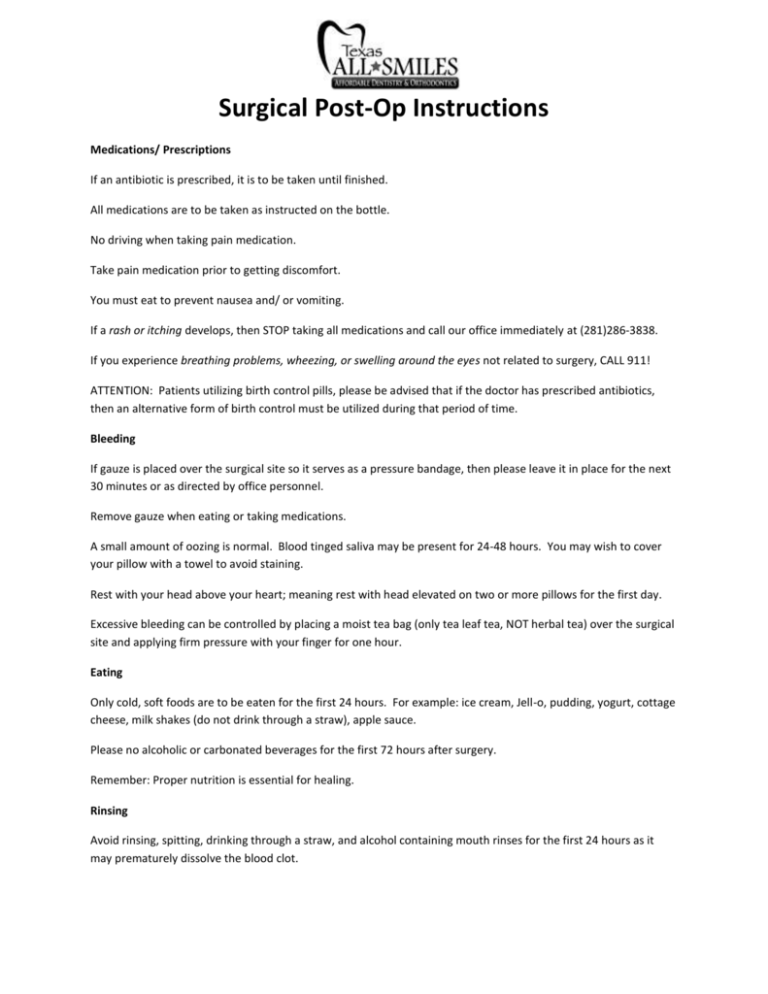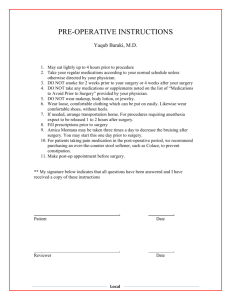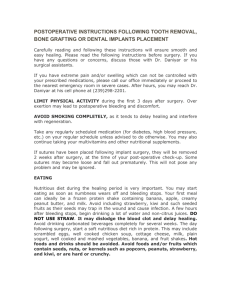Surgical Post-Op Instructions
advertisement

Surgical Post-Op Instructions Medications/ Prescriptions If an antibiotic is prescribed, it is to be taken until finished. All medications are to be taken as instructed on the bottle. No driving when taking pain medication. Take pain medication prior to getting discomfort. You must eat to prevent nausea and/ or vomiting. If a rash or itching develops, then STOP taking all medications and call our office immediately at (281)286-3838. If you experience breathing problems, wheezing, or swelling around the eyes not related to surgery, CALL 911! ATTENTION: Patients utilizing birth control pills, please be advised that if the doctor has prescribed antibiotics, then an alternative form of birth control must be utilized during that period of time. Bleeding If gauze is placed over the surgical site so it serves as a pressure bandage, then please leave it in place for the next 30 minutes or as directed by office personnel. Remove gauze when eating or taking medications. A small amount of oozing is normal. Blood tinged saliva may be present for 24-48 hours. You may wish to cover your pillow with a towel to avoid staining. Rest with your head above your heart; meaning rest with head elevated on two or more pillows for the first day. Excessive bleeding can be controlled by placing a moist tea bag (only tea leaf tea, NOT herbal tea) over the surgical site and applying firm pressure with your finger for one hour. Eating Only cold, soft foods are to be eaten for the first 24 hours. For example: ice cream, Jell-o, pudding, yogurt, cottage cheese, milk shakes (do not drink through a straw), apple sauce. Please no alcoholic or carbonated beverages for the first 72 hours after surgery. Remember: Proper nutrition is essential for healing. Rinsing Avoid rinsing, spitting, drinking through a straw, and alcohol containing mouth rinses for the first 24 hours as it may prematurely dissolve the blood clot. Rinsing gently with warm salt water (one teaspoon of table salt in 8 oz of warm water) after meals and at bedtime for the next 14 days is important. Smoking DON’T DO IT!!!! Smoking will increase pain, lead to poor healing, and failure of the surgery. It will lead to dry sockets, failure of bone regeneration, and failure of dental implants. Swelling Swelling for the first 72 hours after surgery is normal; don’t be alarmed. Ice packs should only be applied for the first 24 hours after surgery. Plastic bags filled with ice and wrapped in a towel are a good mode of application. Apply ice for 20 minutes and then leave off for 10 minutes. AFTER 24 hours ONLY use warm moist heat. This can be applied by taking a shower or with a wash cloth moistened with warm water and then applied to the outside of the face. Bruising Bruising may be present to varying degrees. It will subside over the next 5-10 days. Activity Avoid excessive physical exertion during the first 24 hours following surgery. Be sure to get adequate sleep. Tooth Brushing No tooth brushing the day of surgery. Brushing of the surgical site should be avoided for about one week following surgery to prevent disruption of the blood clot. The remainder of the mouth should be brushed and flossed. Sutures (stitches)/ surgical dressings A variety of sutures and surgical bandages (dressings) may have been used as part of your therapy. They will either dissolve on their own or be removed at the appropriate post operative appointment. Sedative agents The major effects of the sedative agents should have worn off before you are allowed to leave the office. However, there can be residual effects for up to 12 hours. During this time, your reflexes and judgment may be altered. Therefore, you are advised NOT to drive an automobile of operate any machinery during the day of the sedative agent and/ or while taking narcotic pain medications. You may experience light headaches, dizziness, etc. Please do not try to walk without assistance for the next several hours following surgery. Possible conditions following surgery Antibiotics: Diarrhea or stomach upset. Eating active culture yogurt may help. Fever: Temperature may rise slightly for the first 2-3 days following surgery; however a persistent fever should be reported. Muscle stiffness: Should not alarm you. Warm moist heat should be applied. Nausea/ Vomiting: Taking medications on an empty stomach. Keep eating, drinking fluids, and take as few narcotic pain pills as possible. Call the office at (281)286-3838 if severe nausea or vomiting persists. Numbness: Partial numbness may be apparent when the local anesthesia wears off. Time will usually resolve this condition. It could be several weeks of months before feeling returns. Sensations of “tingling, burning, or electric shocks” in the numb area indicate that feeling is returning. Sore Corners of the Mouth: This is best treated by gently applying Vaseline or a similar product. Sharp Bony Edges: Small pieces of bone or bone graft material may work their way out of the surgical site for up to 6 weeks following surgery. If necessary, the removal of these tiny bony spicules is a routine procedure. Dry Socket: This may occur 3-5 days following tooth extraction. Usually, this is characterized by an “earache-like” throbbing pain and foul taste and odor. Treatment involves irrigation and the placement of a surgical dressing. IV Injection Site: May develop a bluish color and then to normal in a few days. Slight tenderness to the area is common and usually of no concern. Treat with moist warm towel and elevation. If you experience swelling or tenderness up toward the shoulder, please call the office at (281)286-3838.









